Pages 112-120
by Sabira Dunyamaliyeva
The styles and characteristics of today´s Azerbaijani national dress have developed over the centuries. Artistic taste, cut, colour, religious symbolism and national tradition have all influenced Azerbaijani clothing. In-depth, comprehensive study of the changes in fashion over time is an important part of art criticism and relates to other areas of culture, such as architecture.
As Azerbaijan is one of the oldest inhabited parts of the world, clothing here dates back millions of years. The first clothes were animal skins wrapped around the body and developed over the years to become the sewn garments that we wear today. National costume emerged and developed as Azerbaijan travelled its long historical path. Different types of clothes have been recorded for posterity in drawings and other art forms.
Azerbaijan is as rich in culture as it is in natural resources, and this can be seen in the range of traditional Azerbaijani dress. National costume consists of under and outer garments and clothes for the upper and lower body. The underclothes include dizlik (trousers or an underskirt) and koynek (a shirt), while the outer garments are shalvar (two tapered trouser legs with a triangular gore inserted into the groin seam) and tuman (several skirts worn on top of one another), qofta (a tunic-like blouse) and arkhaliq (a tunic or shirt). In cold weather bahari or kulaja were worn over the arkhaliq with an eshmak, kurdu (woman´s sleeveless jacket, usually padded or fur-lined), or kurk (sheepskin coat) on top. The outfit was finished off with a headdress and footwear. When women went outside the home, they put on a chadra (chador) or charchab (scarf or shawl), wore chakhchur (a garment made of two trouser legs, each gathered at the ankle into a frilled cuff to which socks of the same fabric were sewn) and fastened a yashmak over their mouth. The cut of outer garments, especially the cut of the arkhaliq, and the colour combinations of clothes differed from region to region.
Azerbaijan women also had complete sets of ceremonial clothes, which were not subject to regional variations. As well as the garments listed above, ceremonial dress included a chapkan (a woman´s garment worn on top of a gown).
Twelve stages can be identified in the formation of Azerbaijani national costume. Each stage saw further development and improvement, corresponding to changing tastes and living conditions. At the same time each new stage stayed faithful to the roots of national dress. Outfits acquired their initial features during Safavid rule in Azerbaijan (1501-1722), but became more sharply defined by region when Azerbaijan was governed by its different khanates. Clothing became a local form of expression, and local styles became firmly established with no-one introducing alien elements. In Azerbaijan, as in the rest of the world, history, geography and function determined the form and colour of clothes. Clothes first of all reflected change in society. Simple forms of clothing, familiar to us since ancient times, were gradually replaced with more complex cuts.
by Sabira Dunyamaliyeva
The styles and characteristics of today´s Azerbaijani national dress have developed over the centuries. Artistic taste, cut, colour, religious symbolism and national tradition have all influenced Azerbaijani clothing. In-depth, comprehensive study of the changes in fashion over time is an important part of art criticism and relates to other areas of culture, such as architecture.
As Azerbaijan is one of the oldest inhabited parts of the world, clothing here dates back millions of years. The first clothes were animal skins wrapped around the body and developed over the years to become the sewn garments that we wear today. National costume emerged and developed as Azerbaijan travelled its long historical path. Different types of clothes have been recorded for posterity in drawings and other art forms.
Azerbaijan is as rich in culture as it is in natural resources, and this can be seen in the range of traditional Azerbaijani dress. National costume consists of under and outer garments and clothes for the upper and lower body. The underclothes include dizlik (trousers or an underskirt) and koynek (a shirt), while the outer garments are shalvar (two tapered trouser legs with a triangular gore inserted into the groin seam) and tuman (several skirts worn on top of one another), qofta (a tunic-like blouse) and arkhaliq (a tunic or shirt). In cold weather bahari or kulaja were worn over the arkhaliq with an eshmak, kurdu (woman´s sleeveless jacket, usually padded or fur-lined), or kurk (sheepskin coat) on top. The outfit was finished off with a headdress and footwear. When women went outside the home, they put on a chadra (chador) or charchab (scarf or shawl), wore chakhchur (a garment made of two trouser legs, each gathered at the ankle into a frilled cuff to which socks of the same fabric were sewn) and fastened a yashmak over their mouth. The cut of outer garments, especially the cut of the arkhaliq, and the colour combinations of clothes differed from region to region.
Azerbaijan women also had complete sets of ceremonial clothes, which were not subject to regional variations. As well as the garments listed above, ceremonial dress included a chapkan (a woman´s garment worn on top of a gown).
Twelve stages can be identified in the formation of Azerbaijani national costume. Each stage saw further development and improvement, corresponding to changing tastes and living conditions. At the same time each new stage stayed faithful to the roots of national dress. Outfits acquired their initial features during Safavid rule in Azerbaijan (1501-1722), but became more sharply defined by region when Azerbaijan was governed by its different khanates. Clothing became a local form of expression, and local styles became firmly established with no-one introducing alien elements. In Azerbaijan, as in the rest of the world, history, geography and function determined the form and colour of clothes. Clothes first of all reflected change in society. Simple forms of clothing, familiar to us since ancient times, were gradually replaced with more complex cuts.
Colour harmony
National craftsmen had a refined sense of colour, and the ability to choose shades of colour was passed down the generations. Tailors used expressions such as “loud red” (alishdim-yandim), “scarlet and green are on friendly terms” (al ile yashil khosh yarashir), “red and yellow, on the lookout” (girmizi-sari, chigirma bari), “white and yellow, good for a dog” (ag ile sari it yasari), which show their careful combination of colour and rejection of clashing tones. This can be clearly seen in the colour palette of Azerbaijan´s national dress. The details and colours in all outfits, whether for the rich and aristocratic or for simple country people, were chosen after careful consideration and random elements were condemned. First of all, colour was guided by the choice of material. The colours and shades used in each complete set of clothes, and in decorative applied art used in daily life, particularly carpets, were selected and co-ordinated as a comprehensive whole with the colours of the geographical environment. The colours of an outfit helped to create a first impression and mood and to express an opinion or intention. This led to the expression “clothes count for first impressions only”. The choice and combination of colour is the main way in which the wearer presents themselves. Details of colour combine in outfits and colours are arranged compatibly. This is colour harmony. Colour harmony was considered a basic requirement in carpet weaving, miniature art, book decoration and other applied arts as well as in fashion.
Individual garments
Let´s take a quick look at initial and more recent developments in Azerbaijani clothing. The history of the dizlik under garment (pants or an underskirt) and the outer shalvar and chakhchur begins long before our era. The first images of these clothes for the lower body can be seen on the rock carvings at Qobustan. These drawings date to the 8th century BC and to the first millennium BC overall. They show the first images of the shalvar (trousers) which later appeared in Azerbaijan.
Women wore three and sometimes as many as 12 tuman or skirts which were outer clothes. The skirts were sewn from the same fabric as a shirt or arkhaliq and in colours that did not clash. The skirt hem was decorated with tirmya, a thin hand-woven woollen fabric, and with lace. In aristocratic families the skirts were sometimes edged with gold and silver coins.
The koynek or shirt, (koynek in Azerbaijani and gomlek in Turkish) are underclothes for the upper body which have been worn since ancient times. They are sewn from simple fabrics. Primitive people wrapped themselves in the skin of hunted animals. The word skin (gon) has been modified - gonlek, gomlek, koynyak - and has reached our times. The outer garments for the lower body include a blouse (kofta, gofta) similar to a shirt but made from expensive, elegant fabrics. Gofta was the first sewn garment put on over the head (in Turkic languages kafadan or kafa means head). The gofta became kaftan which means “put on over the head”. National oral literature, especially the Dada Qorqud epic, refers frequently to the kaftan and images of it can be found in the Gates of Balawat reliefs.
A jubba was a kind of outer garment with a double collar, long tails and sleeves and buttons along lateral seams. The jubba was initially sewn with the pile or fur on the inside and a silk finish on the outside. The jubba was sewn from expensive and elegant fabrics and richly decorated. The cost of these clothes meant that they were valuable gifts and were made for sale. In the Middle Ages the jubba was brought by travellers to Europe, and in particular to Italy, where it became famous as a fur coat or shooba (shooba is the Russian word for fur coat), shaube or djubba. By the end of the Middle Ages the length of the jubba was reduced to half the body and it began to be called the nimtana or half-body. The chapkan-nimtana is an important ceremonial garment for Azerbaijani women.
The arkhaliq is an updated form of the nimtana with a different cut to the collar. The Karabakh arkhaliq had a square collar and resembled a water-lily, while the Baku arkhaliq was rectangular. Borchali and Lankaran arkhaliqs were similar to those from Baku, but the collars of Borchali arkhaliqs had oval corners, and the Lankaran arkhaliqs had a bow-shaped line. The collars of Nakhchivan, Irevan (now Yerevan in Armenia), and Qazakh arkhaliqs were left open and were very decorative. The complex design of the arkhaliq was a major feature of Karabakh clothes and made them especially attractive. The arkhaliq was sewn from expensive fabrics with preference given to “muted” colours. Neither the young, nor the old used “loud” colours. Folds and gathers and the trimmings of cuffs and cuts of collars enhanced the appearance of the arkhaliq.
The pullu chapkan (chapkan decorated with coins) worn in Karabakh was cut in the same form as a nimtana, with the surface decorated with numerous coins.
National costume in Shamakhi was relatively simple but aristocratic clothes showed refinement and riches. Fur was sewn onto sleeves as decoration. The sleeve of the chapkan was trimmed with fur above the elbow and decorated with numerous coins.
The gold coins sewn as decoration onto the hems of skirts and collars of outer garments could be spent as currency, should the need arise.
The bahari was a lined, quilted woman´s garment for the upper body, worn in cold weather. It was closely fitted at the waist and fanned out below the waist. The elbow-length sleeves were cut straight and the collar was left open. The bahari was worn in Karabakh, Baku and Lankaran. The cut and general appearance of Lankaran and Baku baharis are similar.
The kulaja was a lined, quilted woman´s upper garment, widespread in winter in the Nakhchivan region. The sleeves were straight and finished a little below the elbow while the collar was left open. It was richly decorated vertically along the outer seams. The kulaja was mainly made from heavy fabrics such as velvet and tafta (taffeta), and was decorated in a similar way to the hems of outer skirts. Different decorative techniques were used on the kulaja, including gulabatin (golden or silver embroidery), bafta (using braid or lace trims), zanjira (fine needlework), munchuglu tikma (beadwork) and pilakli doldurma (quilting).
The kurdu was a woman´s sleeveless jacket, usually wadded or fur-lined. A body-warmer, it was most often made with the fur or pile on the inside and was finished off on the outside with fabric. Cuffs, collars and hems were decorated with different fur.
The eshmak was a warm garment made of fur with the pile on the inside and finished with fabric. Many eshmaks had an inner lining quilted with wool. The sleeves of the eshmak were elbow-length and the cuffs and other parts were decorated with fur. A big slit was left underneath the sleeves. The eshmak was decorated with lace as well as fur. It was sewn without buttons and worn without fasteners.
The janliq was a simpler form of the kurdu, without decoration, and often fastened by buttons. It was usually worn by poorer people, both men and women. Women from Mughan called the janliq the yal. The yal tended to be made of red or green velvet, while more prosperous women fastened it with nut-shaped buttons. In Irevan the janliq was also known as the ishdik.
The katibi was a type of bahari or kulaja, worn in Borchali (in modern-day Georgia). The katibi had a long, gathered skirt with long sleeves and over-sleeves. The collar was trimmed with fur. The outer vertical seams had decorative coverings.
All women would cover their clothes with a chadra or chador (a large shawl covering the head and body) when they went out. Islamic tradition said that “all women, irrespective of where they live, should cover all parts of the body, except the face, hands and feet.” Under these canons a variety of garments were used to cover the face, including the yashmak (a cloth covering the lower part of the face), chadra, ruband (a light scarf or veil covering the face) and niqab (a face veil with a fine net for the eyes).
Study of the history of Azerbaijan shows that Azerbaijani national costume has developed and improved aesthetically in line with progress in the outlook, taste, and general culture of the Azerbaijani people. Clothing design acquired local features while remaining an integral expression of the people´s aesthetics.
Undoubtedly, Azerbaijani society´s close links with the rest of the world do not promote the development of national costume, and Western styles are now far more widely worn than national dress. Nevertheless, the traditions of national costume remain alive and are an important part of Azerbaijan´s culture.
Sabira Dunyamaliyeva
Senior lecturer at the Azerbaijan State Academy of Fine Arts and a member of the Union of Artists. She is the author of some 55 articles and teaching aids and 20 exhibitions on the history of Azerbaijani costume.
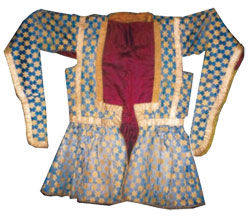
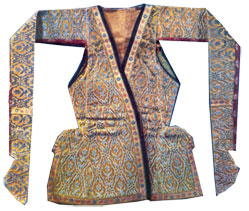
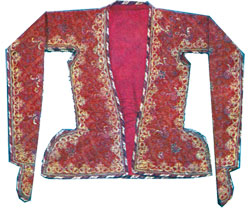
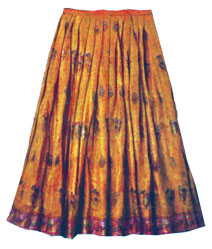
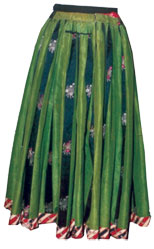
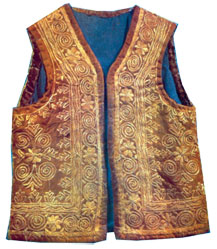
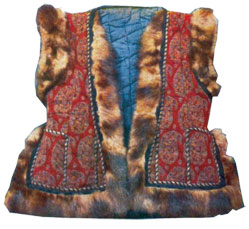
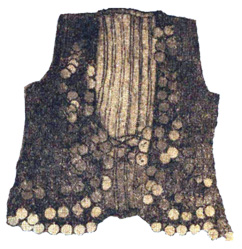
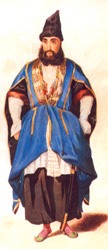
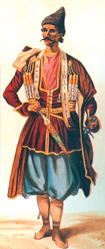
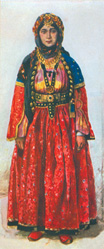
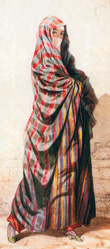
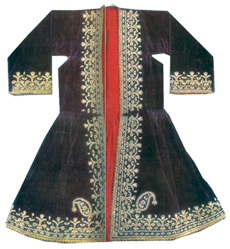
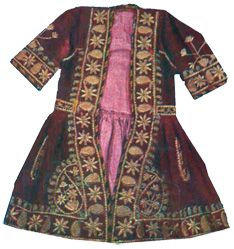

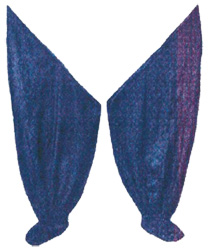
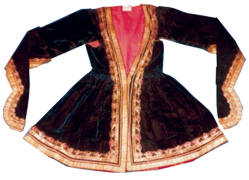
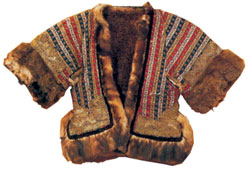
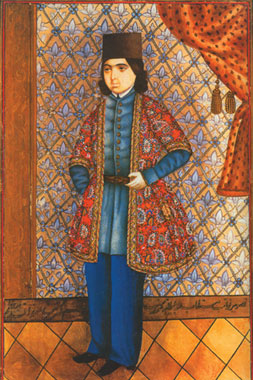
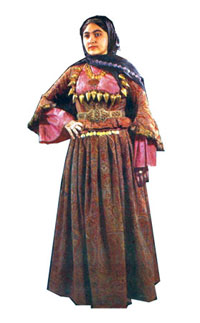
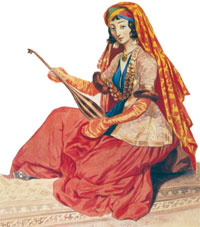
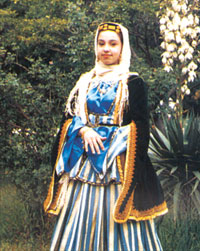
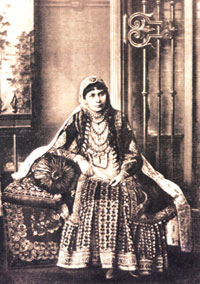
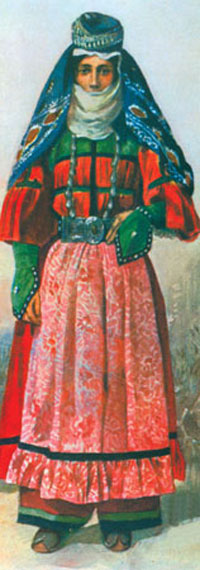
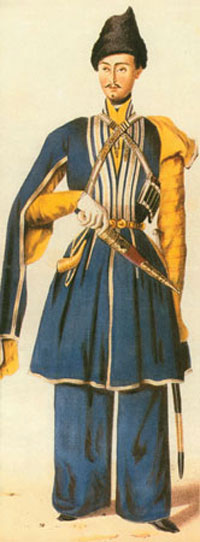


.jpg)